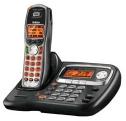Uniden TRU9466 2 Line Telephone System
![]()
![]()
![]()
![]()
![]()
![]()
![]()
![]()

I’m old enough to remember when phones just rang and talked to you – and fortunately, not quite old enough to have experienced the ones with cranks on the side. Such a phone would be regarded as the drooling, imbecile cousin of telecommunications technology today, suitable only for use as a decorative plant stand.
The plethora of high-technology phones available at present usually sees most homes and small businesses with phones in earshot of every room and closet – typically, each one being of a different manufacture and vintage, all with their own controls and features. Hanging up the phone in the living room invariably causes the phone in the master bedroom to lose its call display, and in extreme cases, starts the dishwasher.
An integrated wireless phone system, while somewhat beyond the scope of the electronics section at Walmart, will allow all the phones at your digs to have a common user interface, to share calls seamlessly and to manage a common speed dialing library if you like. In addition, they look cool.
The Uniden TRU9466 is a peach of an integrated phone system – and we tried a number of its competitors before we settled on this one. Clearly the work of designers who have been building phones since cranks were state of the art, it exhibits a wealth of convenient, intuitive features. Perhaps more to the point, it has successfully eschewed many of the noisome gadgets, buttons, screens, accessories, additions and dancing purple wombats much beloved of lower-priced phones, just so the copy on their packaging can say they do all that stuff too.
The TRU9466 consists of a base station and up to ten handsets – you can buy as many of the latter as you need. Uniden actually makes a variety of compatible handsets for this phone system, allowing you to select among its special purpose handsets, and ones that just look impressive. First chance I get, I’m having one of the yellow and black waterproof ones.
Unlike most of the wireless phone systems we looked at, the TRU9466 is genuinely easy to set up. Each handset needs to be registered with the base station – a requirement which appears to be common to all multiple-handset phone systems – but the procedure’s decidedly quick and apparently bulletproof.
Each phone can be given a name – text is entered into the handsets pretty much as you would create text messages for a cell phone.
Each of the TRU9466’s handsets can be set up with its own library of programmed dialing numbers and speed dial. The phones can send all or part of their dialing libraries to other phones in the system, and to the base station. The library dialing is unusually intuitive to set up and use, with most of the interface operating through a four-way navigation button on each handset.
Despite a relative paucity of controls, the TRU9466’s handsets maintain a surprisingly intuitive, easy to follow menu system for such things as setting ring tones, managing the dialing library, activating privacy options and so on.
One of the most remarkable features of the TRU9466 is its sound quality. Even at a considerable distance from the base station, the wireless handsets are clearer than most hard wired phones. Communicating with the base station at 5.8 gigahertz, they appear to be wholly immune to interference from wireless routers, nearby cell phones, hundred-year-old fractional horsepower motors and other inconsiderate technology – things that ultimately spelled the doom of our previous wireless phone system.
The TRU9466 includes an integrated call display in each handset, so you can tell who’s calling before you pick up the phone and pass on the real turkeys.
Unlike several of the other phone systems we looked at, the base station of the TRU9466 is itself a phone, albeit one which can only be used in speaker phone mode if you misplace its handset. The base station has a generous display panel to assist in configuring and maintaining the system.
…oh yes, and there are selectable ring tones for all the handsets. You can assign different ring tones to each line, and if you really like noodling with such things, specific ring tones to known callers, as identified through the caller ID system and entries in the dialing library. The library of ring tones includes various rings, squawks and warbles, and a number of electronic versions of familiar tunes.
The Uniden TRU9466 arguably resides in the upper portion of the price range for two-line wireless phone systems, but it’s worth what it costs. Quick to install, effortless to use and civilized enough not to play The Yellow Rose Of Texas whenever it rings, the only thing it lacks is a button to send a 110-decibel scream down the line when telemarketers call.
Perhaps this will be available in next year’s model.